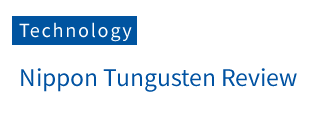Corrosion Behavior of Sintered Ti-Mo Alloy
Kenji NAKAHARA, Kei TOKUMOTO, Shigeya SAKAGUCHI and Yasunori HAYASHI*)
*) Dept. Material Science and Engineering, Fac. Eng., Kyushu University
| Key words |
Sintered Ti-Mo alloy, corrosion resistance, polarization curve, HCl, NaCl |
